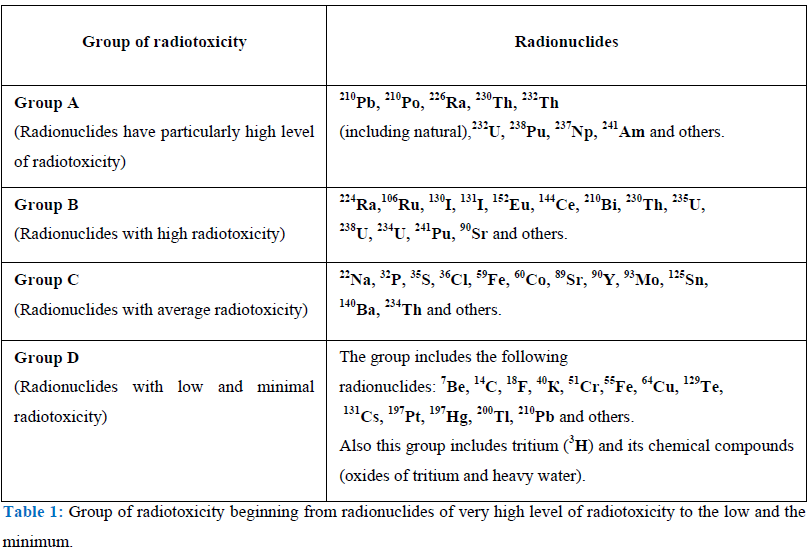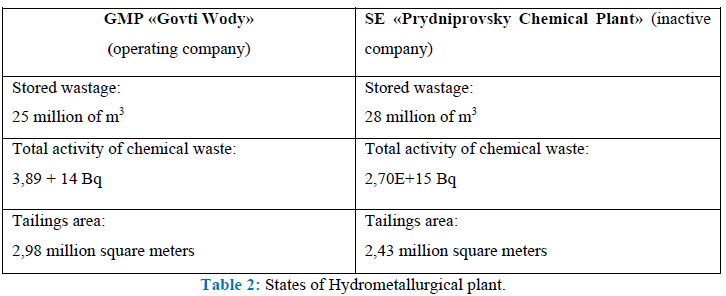Toxicity of Radionuclides in Determining Harmful Effects on Humans and Environment
Poliakova Iryna*
Head of Radiation Technologies Laboratory, State Scientific and Technical Center for Nuclear and Radiation Safety, Kyiv, Ukraine
*Corresponding Author: Poliakova Iryna, Head of Radiation Technologies Laboratory, State Scientific and Technical Center for Nuclear and Radiation Safety, Kyiv, Ukraine
Received: 04 July 2017; Accepted: 28 July 2017; Published: 24 July 2017
Article Information
View / Download Pdf Share at FacebookKeywords
Radiotoxicity, Environment, Extraction, Tailing of radioactive elements, Group of radiotoxicity, Thorium series, Assessment of tails potential dangerous, Chemical hazard, Radiation hazard
Radiotoxicity articles Radiotoxicity Research articles Radiotoxicity review articles Radiotoxicity PubMed articles Radiotoxicity PubMed Central articles Radiotoxicity 2023 articles Radiotoxicity 2024 articles Radiotoxicity Scopus articles Radiotoxicity impact factor journals Radiotoxicity Scopus journals Radiotoxicity PubMed journals Radiotoxicity medical journals Radiotoxicity free journals Radiotoxicity best journals Radiotoxicity top journals Radiotoxicity free medical journals Radiotoxicity famous journals Radiotoxicity Google Scholar indexed journals Environment articles Environment Research articles Environment review articles Environment PubMed articles Environment PubMed Central articles Environment 2023 articles Environment 2024 articles Environment Scopus articles Environment impact factor journals Environment Scopus journals Environment PubMed journals Environment medical journals Environment free journals Environment best journals Environment top journals Environment free medical journals Environment famous journals Environment Google Scholar indexed journals Extraction articles Extraction Research articles Extraction review articles Extraction PubMed articles Extraction PubMed Central articles Extraction 2023 articles Extraction 2024 articles Extraction Scopus articles Extraction impact factor journals Extraction Scopus journals Extraction PubMed journals Extraction medical journals Extraction free journals Extraction best journals Extraction top journals Extraction free medical journals Extraction famous journals Extraction Google Scholar indexed journals Tailing of radioactive elements articles Tailing of radioactive elements Research articles Tailing of radioactive elements review articles Tailing of radioactive elements PubMed articles Tailing of radioactive elements PubMed Central articles Tailing of radioactive elements 2023 articles Tailing of radioactive elements 2024 articles Tailing of radioactive elements Scopus articles Tailing of radioactive elements impact factor journals Tailing of radioactive elements Scopus journals Tailing of radioactive elements PubMed journals Tailing of radioactive elements medical journals Tailing of radioactive elements free journals Tailing of radioactive elements best journals Tailing of radioactive elements top journals Tailing of radioactive elements free medical journals Tailing of radioactive elements famous journals Tailing of radioactive elements Google Scholar indexed journals Group of radiotoxicity articles Group of radiotoxicity Research articles Group of radiotoxicity review articles Group of radiotoxicity PubMed articles Group of radiotoxicity PubMed Central articles Group of radiotoxicity 2023 articles Group of radiotoxicity 2024 articles Group of radiotoxicity Scopus articles Group of radiotoxicity impact factor journals Group of radiotoxicity Scopus journals Group of radiotoxicity PubMed journals Group of radiotoxicity medical journals Group of radiotoxicity free journals Group of radiotoxicity best journals Group of radiotoxicity top journals Group of radiotoxicity free medical journals Group of radiotoxicity famous journals Group of radiotoxicity Google Scholar indexed journals Thorium series articles Thorium series Research articles Thorium series review articles Thorium series PubMed articles Thorium series PubMed Central articles Thorium series 2023 articles Thorium series 2024 articles Thorium series Scopus articles Thorium series impact factor journals Thorium series Scopus journals Thorium series PubMed journals Thorium series medical journals Thorium series free journals Thorium series best journals Thorium series top journals Thorium series free medical journals Thorium series famous journals Thorium series Google Scholar indexed journals Assessment of tails potential dangerous articles Assessment of tails potential dangerous Research articles Assessment of tails potential dangerous review articles Assessment of tails potential dangerous PubMed articles Assessment of tails potential dangerous PubMed Central articles Assessment of tails potential dangerous 2023 articles Assessment of tails potential dangerous 2024 articles Assessment of tails potential dangerous Scopus articles Assessment of tails potential dangerous impact factor journals Assessment of tails potential dangerous Scopus journals Assessment of tails potential dangerous PubMed journals Assessment of tails potential dangerous medical journals Assessment of tails potential dangerous free journals Assessment of tails potential dangerous best journals Assessment of tails potential dangerous top journals Assessment of tails potential dangerous free medical journals Assessment of tails potential dangerous famous journals Assessment of tails potential dangerous Google Scholar indexed journals Chemical hazard articles Chemical hazard Research articles Chemical hazard review articles Chemical hazard PubMed articles Chemical hazard PubMed Central articles Chemical hazard 2023 articles Chemical hazard 2024 articles Chemical hazard Scopus articles Chemical hazard impact factor journals Chemical hazard Scopus journals Chemical hazard PubMed journals Chemical hazard medical journals Chemical hazard free journals Chemical hazard best journals Chemical hazard top journals Chemical hazard free medical journals Chemical hazard famous journals Chemical hazard Google Scholar indexed journals Radiation hazard articles Radiation hazard Research articles Radiation hazard review articles Radiation hazard PubMed articles Radiation hazard PubMed Central articles Radiation hazard 2023 articles Radiation hazard 2024 articles Radiation hazard Scopus articles Radiation hazard impact factor journals Radiation hazard Scopus journals Radiation hazard PubMed journals Radiation hazard medical journals Radiation hazard free journals Radiation hazard best journals Radiation hazard top journals Radiation hazard free medical journals Radiation hazard famous journals Radiation hazard Google Scholar indexed journals ecosystems articles ecosystems Research articles ecosystems review articles ecosystems PubMed articles ecosystems PubMed Central articles ecosystems 2023 articles ecosystems 2024 articles ecosystems Scopus articles ecosystems impact factor journals ecosystems Scopus journals ecosystems PubMed journals ecosystems medical journals ecosystems free journals ecosystems best journals ecosystems top journals ecosystems free medical journals ecosystems famous journals ecosystems Google Scholar indexed journals
Article Details
Untitled Document
1. Toxicity of Radionuclides
All chemical elements and nuclides consolidated in system of elements on a base of periodic law. Nuclides are similar in texture, have a charge and an atomic weight etc. But some of them inherent property of radioactivity. Such elements and nuclides called radionuclides. Chemical elements and their compounds (substances) can negative impact on living organisms and ecosystems. Science of toxicology studies poisonous substances and their potential dangerous, mechanism of action of toxic substations, methods of diagnosis, prevention and treatment. One aspect of development of this science, in context of dangerous of radionuclides, is radiotoxicology.
In conditions, personnel working at industries with combine chemical and radiation hazards there is a toxic load on humans and environment from chemical and radiation components of chemical elements and compounds.
The examples for such enterprises are:
- companies with extracting a mineral resource (iron ore, uranium and thorium ore, gravel, etc.);
- processing of ores (including hydrometallurgical plants);
- radioactive waste management (including reprocessing spent of nuclear fuel at chemical plants);
- processing of enrichment uranium and thorium ores;
- monitoring studies of tailings etc.
In this case radionuclides and their compounds have a double toxicity:
- Chemical toxicity is caused by chemical properties of elements and their compounds that the substance consists.
- Toxic of radioactive elements and nuclides is called radiotoxicity.
The overall impact on the human body will be expressed by the amount of chemical toxicity and radiation toxicity according to the formula:

Tc ? chemical toxicity, Tr - radiation toxicity.
In radiotoxicology all radionuclides consolidated in four groups of radiation danger (group of radiotoxicity): Group A, Group B, Group C, Group D (see Table 1), beginning from radionuclides of very high level of radiotoxicity to the low and the minimum [1-4].

In situations where we have radionuclides of several groups of radiation danger, their activity is equivalent to the Group A of radiotoxicity according with the formula [2]:

A ? total activity. AA, AB, AC, AD ? activity of radionuclides of Groups A, B, C, D.
We should not forget that decaying radionuclides create daughter’s decay products, which can be stable or radioactive.
As for nature radionuclides, which are consolidated in radioactive series, we should take into account the chemical and radiotoxicity impact of each radionuclide with these series (daughter’s decay products). For example, the Series of Thorium:

In this case we should take into account the chemical and radiotoxicity impact (2) of  ,
, ?and only chemical impact of stable . During extracting a mineral resource and their processing there are waste which placed in the territories of the so-called tailing dumps.
?and only chemical impact of stable . During extracting a mineral resource and their processing there are waste which placed in the territories of the so-called tailing dumps.
According to research the territory of Ukraine, there are 344 tailing dumps. Total additional volume of waste in tailings of Ukraine ? 1709 million of cubic meters. Plus there are 11 tailings of waste after the processing of uranium ores.
Such objects are identified on all parts of the territory of Ukraine except Crimea region, Zakarpatska region, Volynsck region, Ternopil region, Odesa and Khmelnytsk regions (Figure 1).

The information received from:
145 objects (Violet) ? Scientific Research Institute of Micrograph State Archival Service of Ukraine (2014).
199 objects (Blue) - Register of Waste Disposal of Ukraine Ministry of Environmental Protection (2015).
Table 2 shows the brief data of states of Hydrometallurgical plant ?Govti Wody? (GMP ?Govti Wody?, operating company) and State Enterprise ?Prydniprovskyi Chemical Plant? (SE ?Prydniprovskyi Chemical Plant?, inactive company). In the tailes of these enterprises there are preserving chemical elements and there are compounds which are nature occurring radioactive materials (waste after processing of uranium ores).

For the goal of assessment of tails’ potential danger for humans and environment we propose determine the potential danger index (IPNN). The scheme of forming of IPNN is shown in Figure 2 [7].

The higher the IPNN, the higher the level of danger of tailings for humans and environment. The maximum contribution to the level of IPNN creates IPNN, which is the index of the ?toxicity?, and IPNN which is the index of the ?volume?.
After the assessment of tailings of enterprises GMP ?Govti Wody? and SE ?Prydniprovsky Chemical Plant? we got the next results. The more dangerous influence has SE ?Prydniprovskyi Chemical Plant?. The database of IPNNmanagement is absent and the information about the volume of ?tailings? stored in the tailings (storage) (IPNNvolume) is absent partly.
2. Conclusions
When the extraction of mineral resources and preserving of waste after the processing of ores we get not only chemical influence for humans and environment. Many experts do not consider the radiation impact because they think that these mineral resources don’t have radiation sources. It is false. In this case, we loose the significant part of dangerous factors that affect on people and environment. Thus, the results of assessing the impact of any tailing of industrial enterprises (not only uranium) is doubtful. Taking into accounting the radiotoxicity in IPNNtoxic we can get more reliable information about the state of tailings and there are influence for humans and environment.
References
- NRBU-97. Radiation Safety Standards of Ukraine. State Health and Safety Standards (1997).
- State Health and Safety Rules . 6.177-2005-09-02: Basic Health and Safety Rules for Radiation Safety of Ukraine (OSPU-2005) (2005): 197.
- Osnovni sanitarni pravyla zabezpechennia radiatciinoi bezpeky Ukrainy (OSPU-2005)], Ofitsiinyi Visnyk Ukrainy (2005): 197.
- Methods for the determination of toxicity and hazard of chemicals (toxicometry): Handbook / Edited by Sanotskyy I, Medicine, Moscow (1970): 42-46.
- Zakutinskiy DI, Parfenov Yu D, Selivanova LI. Handbook on toxicology of radioactive elements, State publishing house of medical literature, Moscow (1962): 115.
- Database of Scientific Research Institute of Micrograph State Archival Service of Ukraine (2014).
- Register of Waste Disposal of Ukraine Ministry of Environmental Protection (2015).
- Improving the safety of industrial tailings management facilities based on the example of Ukrainian facilities (2017): 242.


 Impact Factor: * 3.6
Impact Factor: * 3.6 Acceptance Rate: 76.49%
Acceptance Rate: 76.49%  Time to first decision: 10.4 days
Time to first decision: 10.4 days  Time from article received to acceptance: 2-3 weeks
Time from article received to acceptance: 2-3 weeks 